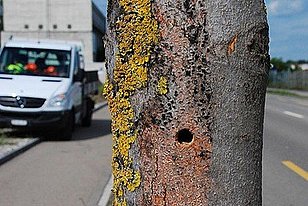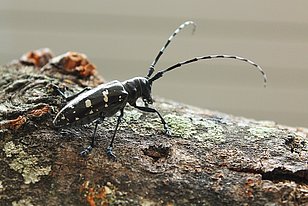31.08.2024 | Beate Kittl/Benno Augustinus | WSL News
There are more than 1300 tree species in Swiss cities, while our forests are home to only 76, according to a study by the Swiss Federal Institute for Forest, Snow and Landscape Research (WSL). This means that introduced forest pests or diseases also find significantly more potential hosts in cities – and could spread from there into the forests.
Forest protection expert Benno Augustinus and his colleagues compared the composition of tree species in 26 Swiss cities with that in surrounding forests. To do this, they searched through tree registers from all over Switzerland. A tree register is a directory in which, for example, municipalities record individual trees. A total of over 500,000 city trees were recorded in this way
It was found that the cities have an enormous diversity of species: more than 1,300 tree species grow here, most of them not native, while only 76 species grow in the surrounding forests. This astounding diversity in cities needs to be put into perspective, because in most cases a few species dominate in terms of numbers, such as maples and limes. This is even more pronounced in natural forests: in forests within a radius of 10 km of cities, spruce and beech trees are the most common – and then there is a long stretch of nothing. ‘This alone makes our comparison between urban and surrounding forest trees worthwhile. After all, cities are generally considered to be poor in diversity and forests to be rich,’ explains Augustinus. In reality, it is the other way around.
Gateways for invasive species ¶
This makes cities attractive to pests. The scientists have calculated where potentially dangerous forest pests (so-called quarantine pests) find the most suitable hosts. Examples include the Bronze Birch Borer (Agrilus anxius) on birch trees or the Red-necked Longhorn Beetle (Aromia bungii) on fruit trees. The result: due to the large variety of trees in cities, introduced pests have a higher percentage of hosts in cities than in forests. This is relevant because most invasive species are introduced through trade, which takes place in urban areas, not in the middle of the forest. As a result of international trade in goods and people, more and more forest and agricultural pests are being transported across the world.
In practical terms, this means that urban trees can act as gateways for invasive forest pests. If we want to protect the forest from them, it makes sense to keep an eye out for incoming pests in the city. ‘It helps a lot if the public also keeps an eye out for diseased trees,’ says Augustinus. In addition, urban trees could be better protected by drawing on the expertise of forestry companies. ‘Our study can also be seen as a call for more cooperation between foresters and managers of urban green spaces,’ says Augustinus.
Contact ¶
Publication ¶
Augustinus B.A., Abegg M., Queloz V., Brockerhoff E.G. (2024) Higher tree species richness and diversity in urban areas than in forests: implications for host availability for invasive tree pests and pathogens. Landsc. Urban Plan. 250, 105144 (10 pp.). https://doi.org/10.1016/j.landurbplan.2024.105144Institutional Repository DORA
Always up to date: Subscribe to the WSL Newsletter
Copyright ¶
WSL and SLF provide image and sound material free of charge for use in the context of press contributions in connection with this media release. The transfer of this material to image, sound and/or video databases and the sale of the material by third parties are not permitted.




